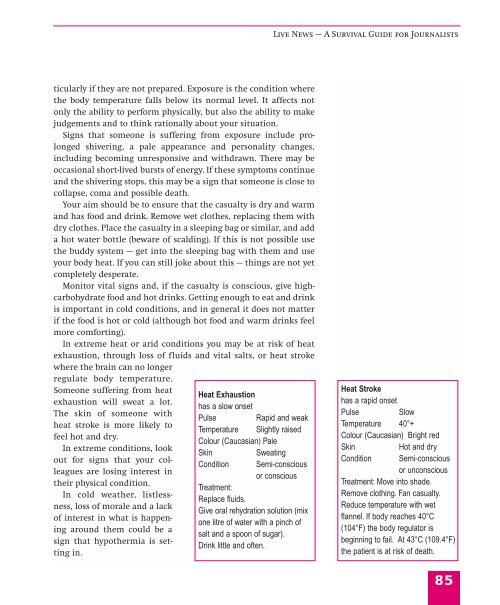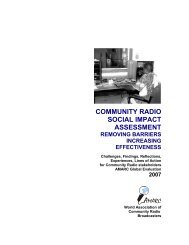Live News - A Survival Guide - International Federation of Journalists
Live News - A Survival Guide - International Federation of Journalists
Live News - A Survival Guide - International Federation of Journalists
- No tags were found...
You also want an ePaper? Increase the reach of your titles
YUMPU automatically turns print PDFs into web optimized ePapers that Google loves.
<strong>Live</strong> <strong>News</strong> — A <strong>Survival</strong> <strong>Guide</strong> for <strong>Journalists</strong>ticularly if they are not prepared. Exposure is the condition wherethe body temperature falls below its normal level. It affects notonly the ability to perform physically, but also the ability to makejudgements and to think rationally about your situation.Signs that someone is suffering from exposure include prolongedshivering, a pale appearance and personality changes,including becoming unresponsive and withdrawn. There may beoccasional short-lived bursts <strong>of</strong> energy. If these symptoms continueand the shivering stops, this may be a sign that someone is close tocollapse, coma and possible death.Your aim should be to ensure that the casualty is dry and warmand has food and drink. Remove wet clothes, replacing them withdry clothes. Place the casualty in a sleeping bag or similar, and adda hot water bottle (beware <strong>of</strong> scalding). If this is not possible usethe buddy system — get into the sleeping bag with them and useyour body heat. If you can still joke about this — things are not yetcompletely desperate.Monitor vital signs and, if the casualty is conscious, give highcarbohydratefood and hot drinks. Getting enough to eat and drinkis important in cold conditions, and in general it does not matterif the food is hot or cold (although hot food and warm drinks feelmore comforting).In extreme heat or arid conditions you may be at risk <strong>of</strong> heatexhaustion, through loss <strong>of</strong> fluids and vital salts, or heat strokewhere the brain can no longerregulate body temperature.Someone suffering from heatexhaustion will sweat a lot.The skin <strong>of</strong> someone withheat stroke is more likely t<strong>of</strong>eel hot and dry.In extreme conditions, lookout for signs that your colleaguesare losing interest intheir physical condition.In cold weather, listlessness,loss <strong>of</strong> morale and a lack<strong>of</strong> interest in what is happeningaround them could be asign that hypothermia is settingin.Heat Exhaustionhas a slow onsetPulseRapid and weakTemperature Slightly raisedColour (Caucasian) PaleSkinSweatingCondition Semi-consciousor consciousTreatment:Replace fluids.Give oral rehydration solution (mixone litre <strong>of</strong> water with a pinch <strong>of</strong>salt and a spoon <strong>of</strong> sugar).Drink little and <strong>of</strong>ten.Heat Strokehas a rapid onsetPulseSlowTemperature 40°+Colour (Caucasian) Bright redSkinHot and dryCondition Semi-consciousor unconsciousTreatment: Move into shade.Remove clothing. Fan casualty.Reduce temperature with wetflannel. If body reaches 40°C(104°F) the body regulator isbeginning to fail. At 43°C (109.4°F)the patient is at risk <strong>of</strong> death.85
















